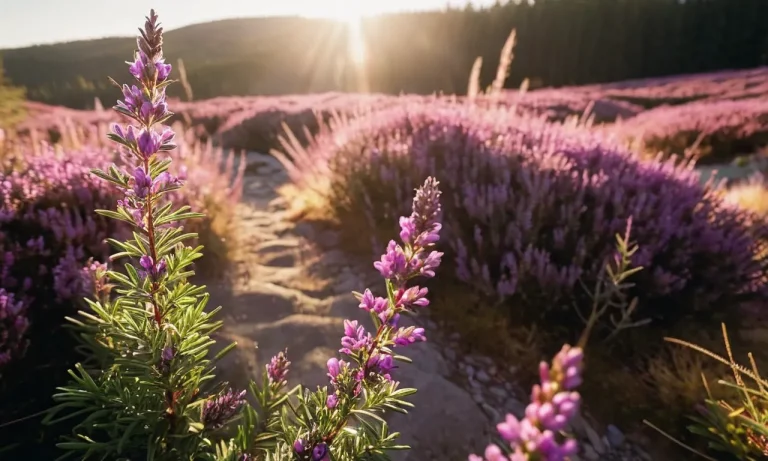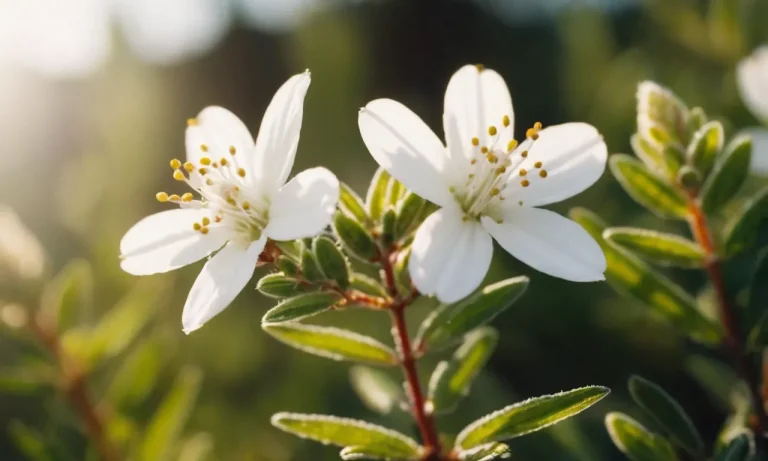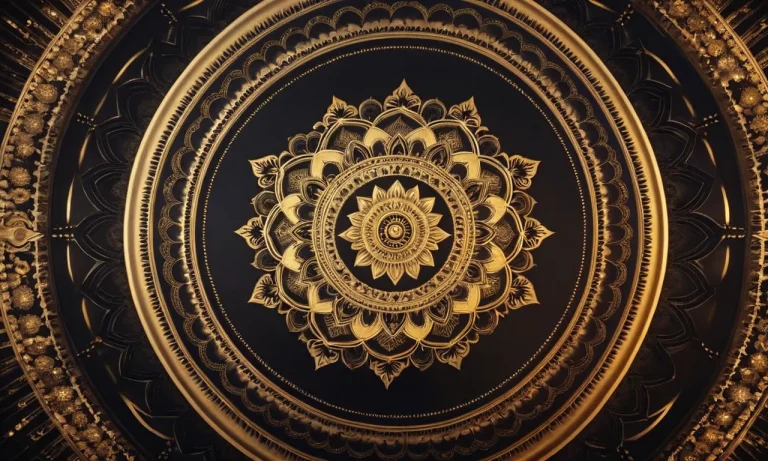The rose is often called the ‘Queen of Flowers’ and has been revered for its beauty and fragrance for centuries across many cultures and spiritual traditions. If you’re wondering about the deeper symbolic and spiritual meaning behind this beloved flower, you’ve come to the right place.
If you’re short on time, here’s a quick answer to your question: Roses have complex spiritual symbolism related to love, beauty, balance, wisdom, gratitude, devotion and the human soul. Different rose colors have additional meanings, like red for passion or white for purity.
In this comprehensive guide, we’ll explore the rich spiritual meanings and mythologies around roses found in religions and beliefs worldwide. We’ll cover the mystical significance behind rose colors, examine rose symbolism in ancient cultures and spiritual texts, and unpack the flower’s role in ceremonies and rituals. By the end, you’ll have a deep understanding of the rose’s profound place in the human quest for meaning.
Symbolic Meanings in Ancient Cultures and Spiritual Traditions
Roses have held a special place in various ancient cultures and spiritual traditions throughout history. Their beauty and fragrance have captivated people’s hearts and inspired numerous symbolic meanings. Let’s explore how roses have been interpreted in different belief systems.
Ancient Greece and Rome
In ancient Greece and Rome, roses were associated with love, beauty, and passion. The Greek goddess of love, Aphrodite, was often depicted with roses. The Romans also believed that roses were sacred to Venus, their goddess of love. Roses were used to symbolize love and desire, and they were often given as offerings during weddings and celebrations.
Christianity
In Christianity, roses are often associated with the Virgin Mary and the concept of purity. The red rose came to symbolize the blood of Christ and martyrdom, while the white rose represented purity and innocence. In religious art, the Virgin Mary is sometimes depicted with roses, symbolizing her divine beauty and virtue.
Islam
In Islam, roses are highly revered and are often mentioned in poetry and literature. The rose is seen as a symbol of beauty, love, and spirituality. It is believed that the Prophet Muhammad had a deep appreciation for roses and would often surround himself with their fragrance.
Judaism
In Judaism, roses are associated with the biblical Song of Solomon, which uses the imagery of a rose to describe the beloved. The rose is seen as a symbol of love and passion in Jewish tradition. Additionally, roses are often used in Jewish rituals and celebrations, such as weddings and bar mitzvahs.
Hinduism and Buddhism
In Hinduism and Buddhism, roses are used in religious ceremonies and rituals. They are seen as a symbol of divine love and beauty. In Hindu mythology, the goddess Lakshmi is often depicted holding a lotus flower and a rose, symbolizing prosperity and spiritual growth.
Chinese Culture
In Chinese culture, roses have been associated with beauty, luck, and good fortune. The Chinese have cultivated roses for thousands of years and have developed many varieties with unique meanings. For example, the yellow rose symbolizes friendship and joy, while the red rose represents love and romance.
Understanding the symbolic meanings of roses in ancient cultures and spiritual traditions adds a deeper appreciation for these beautiful flowers. Whether you’re giving or receiving roses, remember the rich history and spiritual significance they hold.
The Significance of Rose Colors
Roses are not just beautiful flowers, but they also hold deep symbolic meanings depending on their colors. Each color represents a different emotion or sentiment, making roses a popular choice for various occasions. Let’s explore the significance of different rose colors:
Red Roses
Red roses are the epitome of love and passion. They are often associated with romance and are commonly given on Valentine’s Day or anniversaries. Red roses symbolize deep affection and desire, conveying a message of love and devotion.
White Roses
White roses represent purity, innocence, and new beginnings. They are often used in weddings and symbolize the start of a new chapter in life. White roses also convey a sense of reverence and can be given to show sympathy or honor someone’s memory.
Pink Roses
Pink roses symbolize grace, gratitude, and admiration. They are often given as a token of appreciation or to express feelings of joy and happiness. Pink roses can also represent gentle love and femininity, making them a popular choice for Mother’s Day or to celebrate a new baby.
Yellow Roses
Yellow roses are associated with friendship and joy. They can brighten someone’s day and are often given to express platonic love or to celebrate a special bond. Yellow roses can also convey a sense of warmth and happiness, making them a great choice for birthdays or to cheer someone up.
Orange Roses
Orange roses symbolize enthusiasm, passion, and excitement. They are vibrant and energetic, making them a perfect choice to convey a message of enthusiasm or to celebrate an achievement. Orange roses can also represent a sense of fascination or attraction.
Lavender Roses
Lavender roses are a symbol of enchantment and love at first sight. They carry a sense of wonder and mystery, often associated with new beginnings or budding romance. Lavender roses can also represent elegance and grace, making them a unique and thoughtful choice.
Blue Roses
Blue roses are not naturally occurring but are often associated with the unattainable or the mysterious. They can symbolize a sense of longing or desire for the impossible. While blue roses are not readily available, they can be created through dyeing or genetic modification.
Green Roses
Green roses are a symbol of life, renewal, and fertility. They represent growth and abundance, making them a great choice for celebrations or to wish someone good luck. Green roses can also symbolize harmony and balance.
Black Roses
Black roses are often associated with death and mourning. They can symbolize the end of a relationship or loss. However, it’s important to note that black roses do not exist naturally. Dark red or burgundy roses are often mistaken for black roses due to their deep color.
Understanding the significance of rose colors adds an extra layer of meaning to the act of giving and receiving roses. Whether you’re expressing love, gratitude, friendship, or sympathy, choosing the right color can help convey your emotions effectively.
Roses in Rituals, Ceremonies and Celebrations
Roses have been a symbol of beauty, love, and spirituality for centuries. Their enchanting fragrance and vibrant colors make them a popular choice for various rituals, ceremonies, and celebrations. In this section, we will explore the significance of roses in different cultural and spiritual contexts.
Weddings
When it comes to weddings, roses are often the flower of choice. Their elegant appearance and sweet scent make them a perfect symbol of love and romance. Roses can be found in bridal bouquets, centerpieces, and even in the decorations of the wedding venue. The colors of roses also hold special meanings in weddings – red roses symbolize love and passion, while white roses represent purity and innocence.
Spiritual Rituals and Ceremonies
Roses have deep spiritual significance and are often used in various rituals and ceremonies. In many religious traditions, roses are seen as a symbol of divinity and are used to honor deities or invoke spiritual blessings. For example, in Hinduism, roses are offered to deities as a form of devotion. In Christianity, roses are associated with the Virgin Mary and are used in the Rosary prayers.
The Rosicrucians
The Rosicrucians, a mystical and philosophical society, have a deep connection with roses. They consider the rose as a symbol of spiritual awakening and enlightenment. The rose is seen as a representation of the soul’s journey towards self-realization and divine wisdom. The Rosicrucians often use the image of a rose in their teachings and rituals to convey these mystical concepts.
The Rose in Alchemy
In alchemy, the rose holds a significant place. It is seen as a powerful symbol of transformation and spiritual growth. The alchemical process of turning base metals into gold, known as the Philosopher’s Stone, is often represented by a rose. The petals of the rose are seen as different stages of purification and refinement that one must go through to achieve spiritual enlightenment.
Rose Festivals
Many cultures around the world celebrate roses through vibrant festivals. These festivals not only showcase the beauty of roses but also honor their spiritual and cultural significance. For example, the Rose Parade in Pasadena, California, is a famous annual event that features elaborate floats adorned with thousands of roses. The festival attracts visitors from all over the world who come to admire the stunning displays of roses and celebrate their beauty.
Rose Symbolism in Tarot and Divination
When it comes to tarot and divination, roses hold significant symbolism and are often used to convey deeper meanings in various cards. Let’s explore some of the key cards in the tarot deck that feature rose symbolism.
The Fool Card
The Fool, representing new beginnings and unlimited potential, often includes a rose in his hand or at his feet. This symbolizes the blossoming of new opportunities and the beauty that can be found in embracing the unknown. The rose in this card reminds us to approach life’s journey with optimism and a sense of adventure.
Strength Card
The Strength card depicts a woman gently taming a lion. It is a card that represents inner strength, courage, and compassion. In some tarot decks, the woman in this card holds a rose in her hand, symbolizing the delicate balance between power and gentleness. The rose reminds us that true strength lies not in forceful domination, but in the ability to harness our emotions and act with kindness.
The Magician Card
The Magician is a card of manifestation and transformation. With one hand pointing towards the heavens and the other towards the earth, the Magician channels the energy of the universe to bring about change. In some decks, a rose appears on the table before the Magician, representing the power of creation and the ability to manifest our desires through focused intention.
Other Cards with Rose Symbolism
Besides the Fool, Strength, and Magician cards, roses can be found in other tarot cards as well. For example, the Lovers card often features roses as a symbol of love, passion, and unity. The Empress card may also include roses, representing fertility, abundance, and nurturing energy.
It’s important to note that the interpretation of tarot cards is highly subjective and can vary depending on the reader. The presence of roses in these cards adds an additional layer of symbolism, inviting us to explore the deeper meanings and messages they convey.
If you are interested in learning more about tarot symbolism and rose meanings in divination, Tarot.com has a wealth of resources and articles that can further enhance your understanding.
The Rose in Literature, Art and Culture
Roses have captivated the hearts and minds of people for centuries, and their timeless beauty has made them a popular subject in various forms of artistic expression. From art and sculpture to poetry and literature, and even music and film, the rose holds a significant place in our cultural heritage.
Art and Sculpture
Throughout history, artists have been inspired by the beauty and symbolism of roses. Paintings featuring roses can be found in many art periods, from the delicate depictions in Renaissance art to the bold and vibrant interpretations of the Impressionists. One of the most famous paintings featuring roses is “Les Roses” by Pierre-Joseph Redouté, a renowned botanical artist. This stunning artwork showcases the intricate details and colors of different rose varieties.
In sculpture, the rose has been represented in various forms. Many sculptures feature rose motifs or incorporate roses as part of larger installations. For example, the “Rose” sculpture by Isamu Noguchi is a striking piece that combines the elegance of a rose with abstract design elements, creating a visually captivating representation of the flower.
Poetry and Literature
Countless poets and writers have used the rose as a symbol of love, beauty, and passion in their works. From Shakespeare’s famous line, “A rose by any other name would smell as sweet,” to Rumi’s profound verses comparing the rose to the beloved, the rose has been a source of inspiration for poets and writers across cultures and time periods.
One notable example is the 19th-century poet Robert Burns, who wrote the famous poem “A Red, Red Rose.” In this poem, Burns compares his love to a red rose, expressing the depth of his emotions. The rose becomes a powerful symbol of enduring love and beauty.
Music and Film
The rose has also found its way into the world of music and film, where its symbolism continues to resonate. In music, the rose has been a recurring theme in songs across genres. From ballads to rock anthems, artists have used the rose as a metaphor for love, longing, and even rebellion. Songs like “The Rose” by Bette Midler and “Bed of Roses” by Bon Jovi have become iconic in their representation of the rose’s emotional depth.
In film, roses often carry symbolic meanings and play significant roles in storytelling. From the enchanted rose in Disney’s “Beauty and the Beast” to the rose petals in “American Beauty,” these cinematic representations add layers of symbolism and depth to the narratives, enhancing the overall impact of the stories.
The rose’s presence in literature, art, and culture is a testament to its universal appeal and enduring significance. Its beauty and symbolism continue to inspire and captivate audiences across different artistic mediums, reminding us of the profound impact a simple flower can have on our lives.
Conclusion
The rose has captivated imaginations across cultures for millennia with its sublime beauty and intoxicating fragrance. But beyond the flower’s physical perfection lies a deeply layered symbology reflecting humanity’s highest aspirations. The rose embodies tantalizing paradoxes – passion and purity, pleasure and pain, beauty and mortality. No other flower quite captures the joy, sorrow, and mystery of what it means to be human.
When we slow down to observe a rose – notice its spiraling patterns, its delicate layers concealing hidden depths – we’re reminded of nature’s mysteries unfolding around and within us. We touch a wisdom beyond words or rational thought. The rose mirrors the unfolding of our own soul, encouraging us to open our hearts and minds to life’s beauty, blessings, and thorns. This ancient, sacred flower continues to evolve in meaning – but its message of love is eternal.






